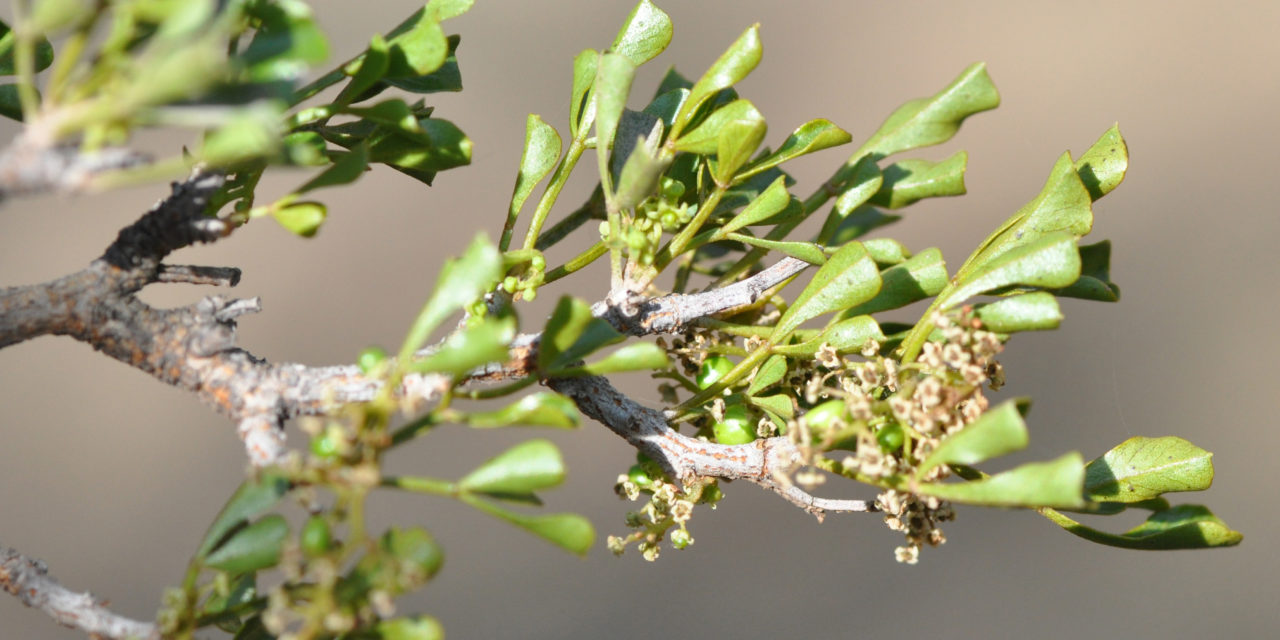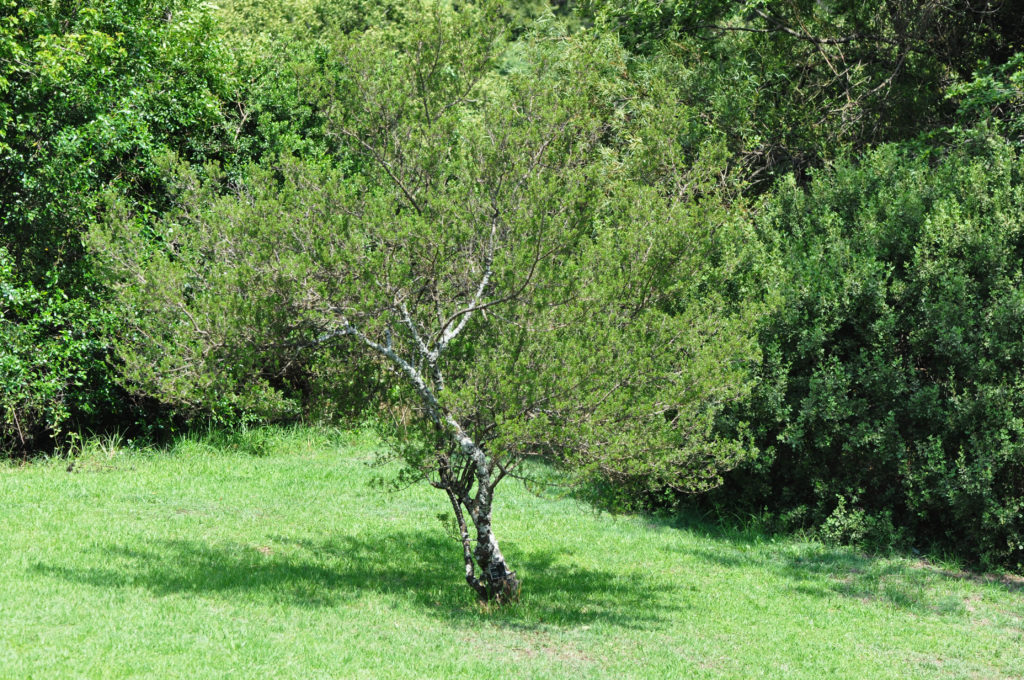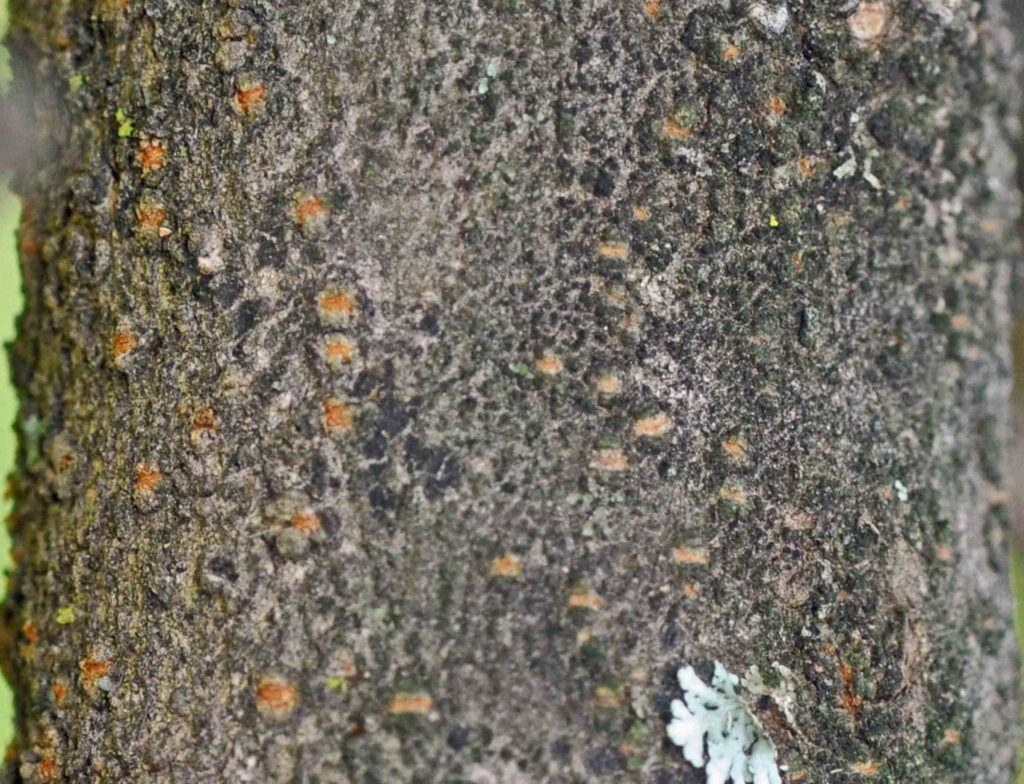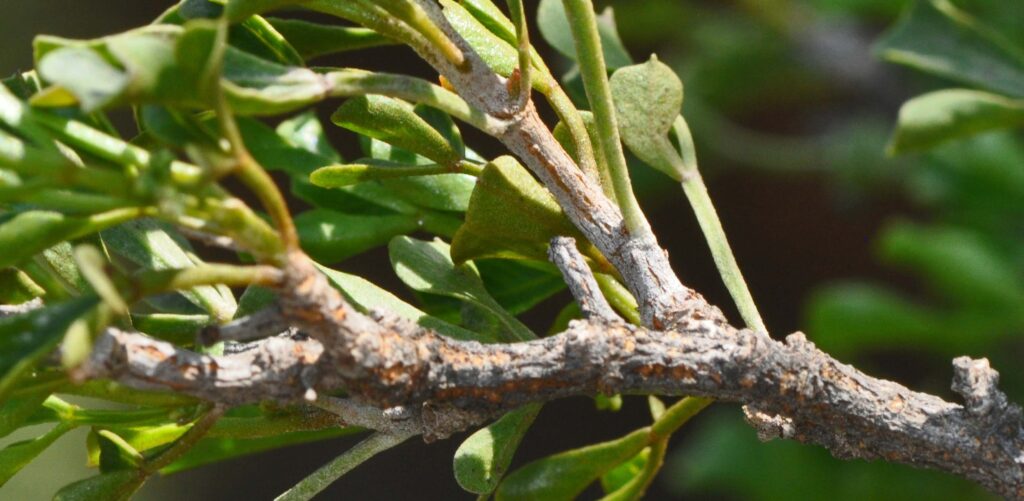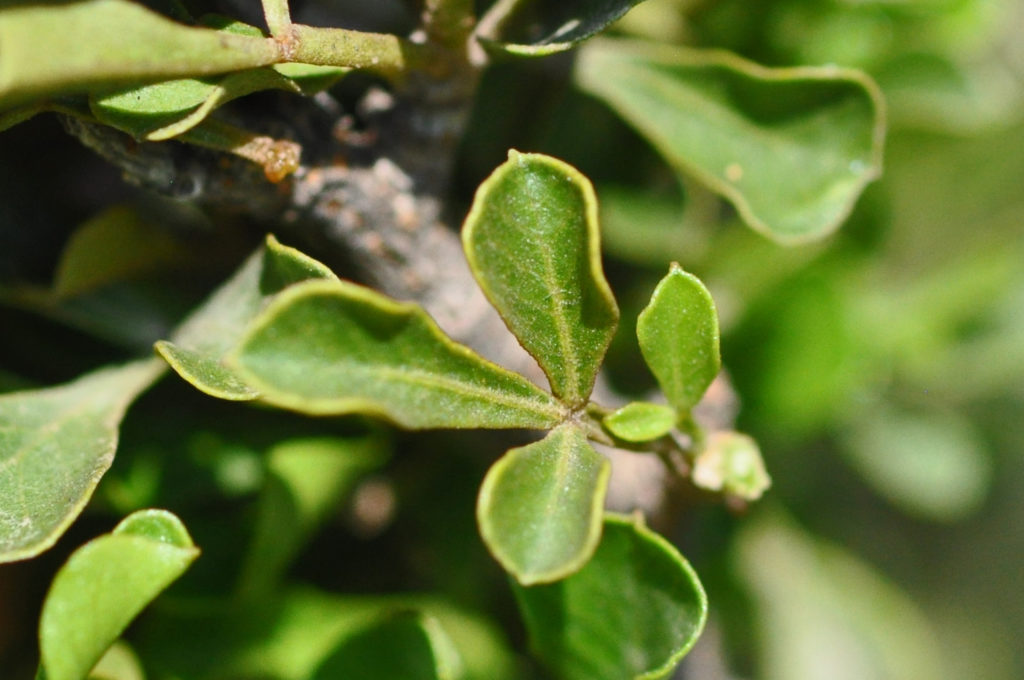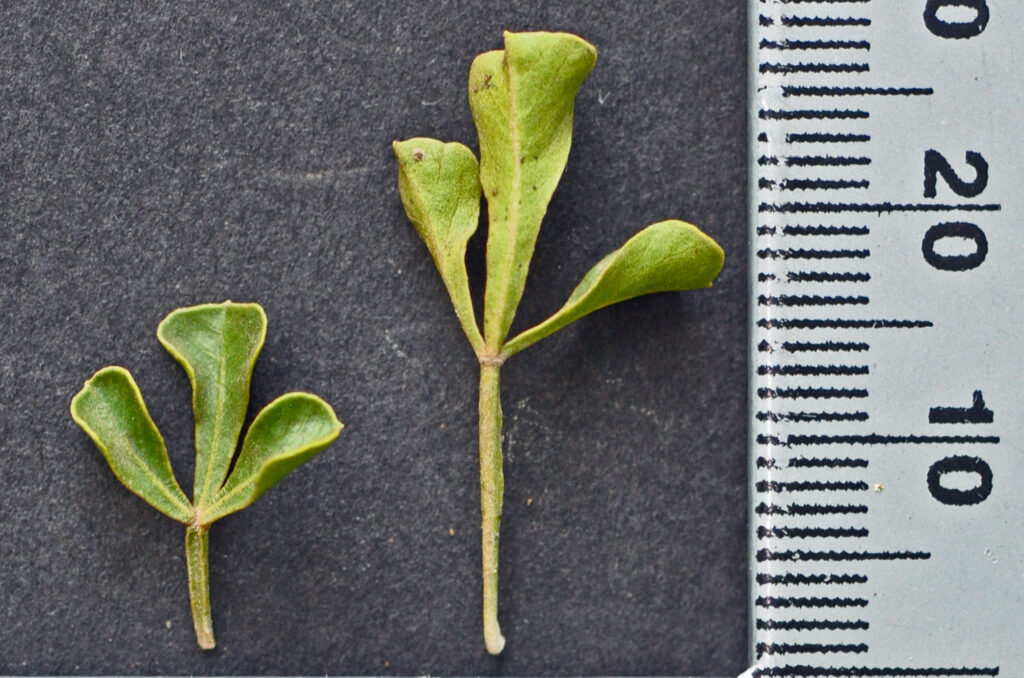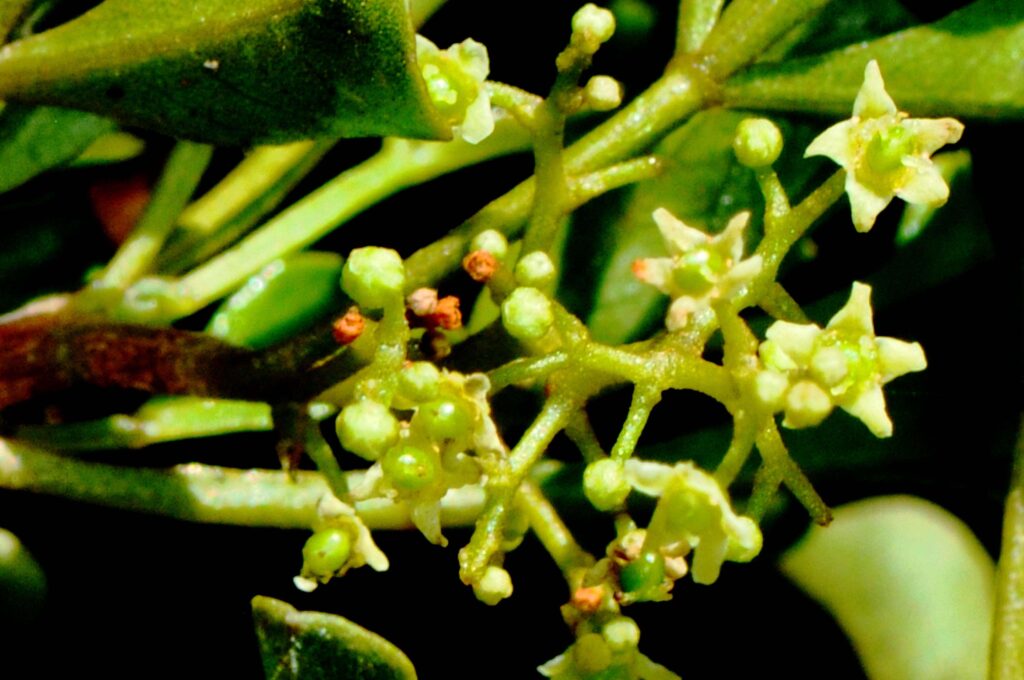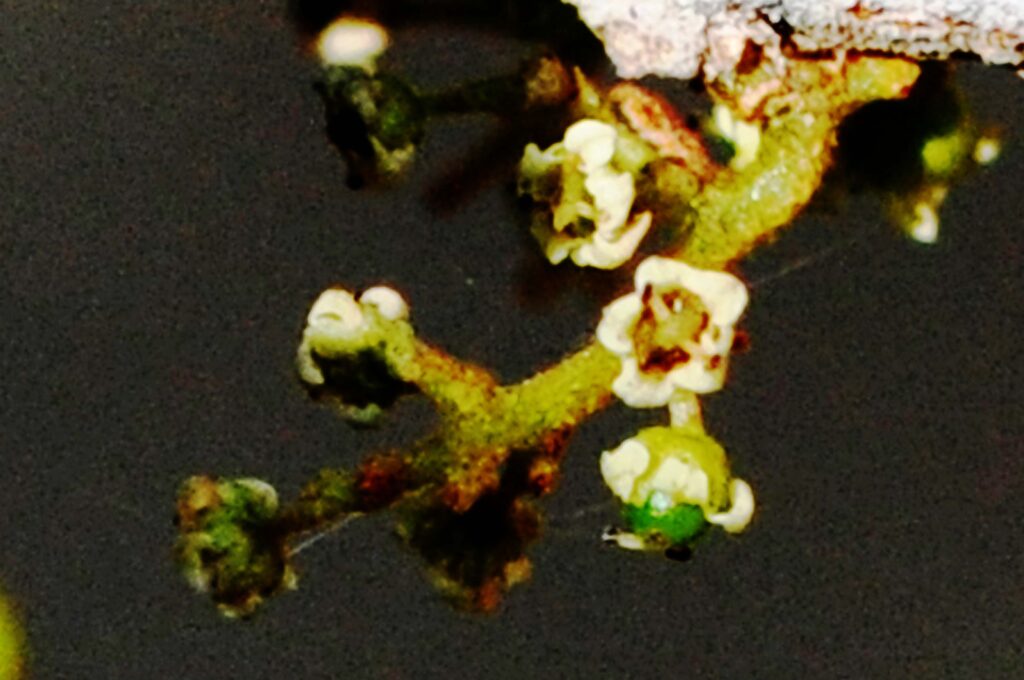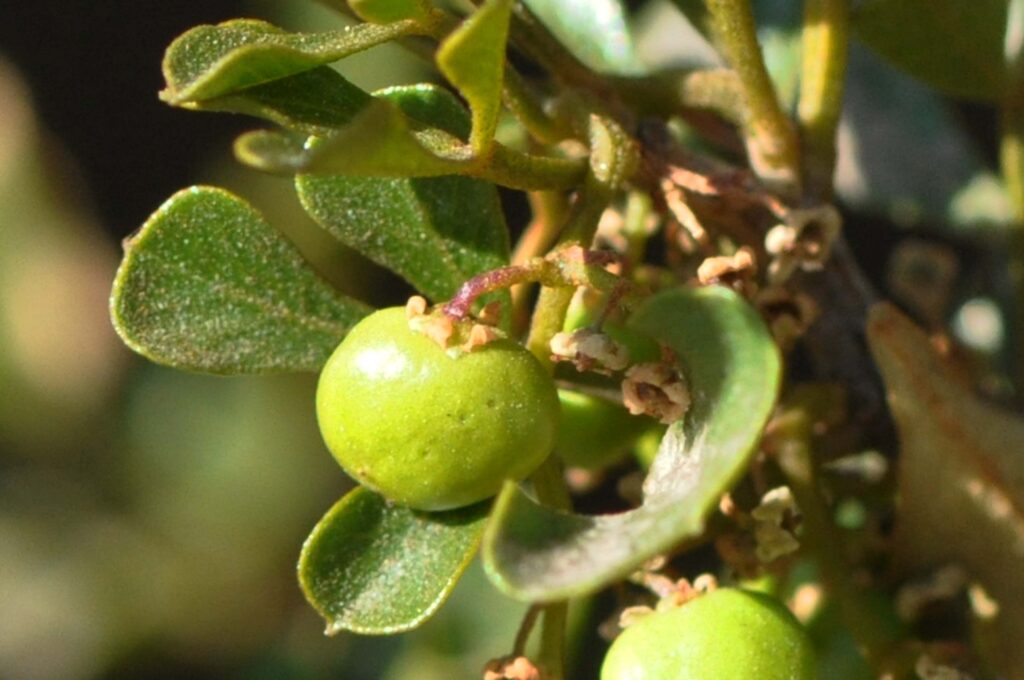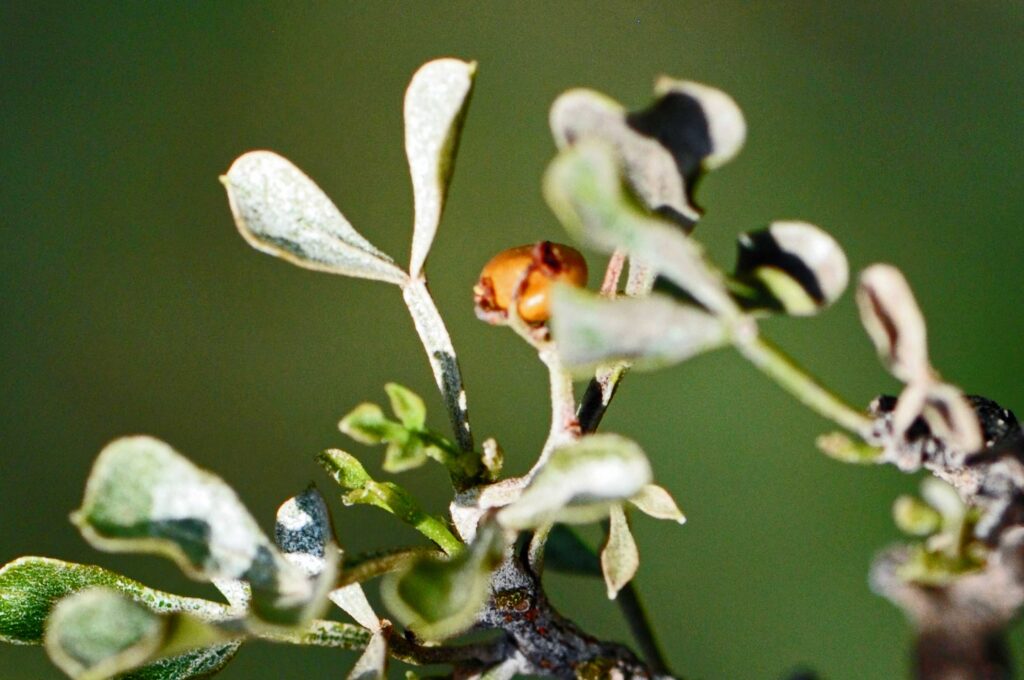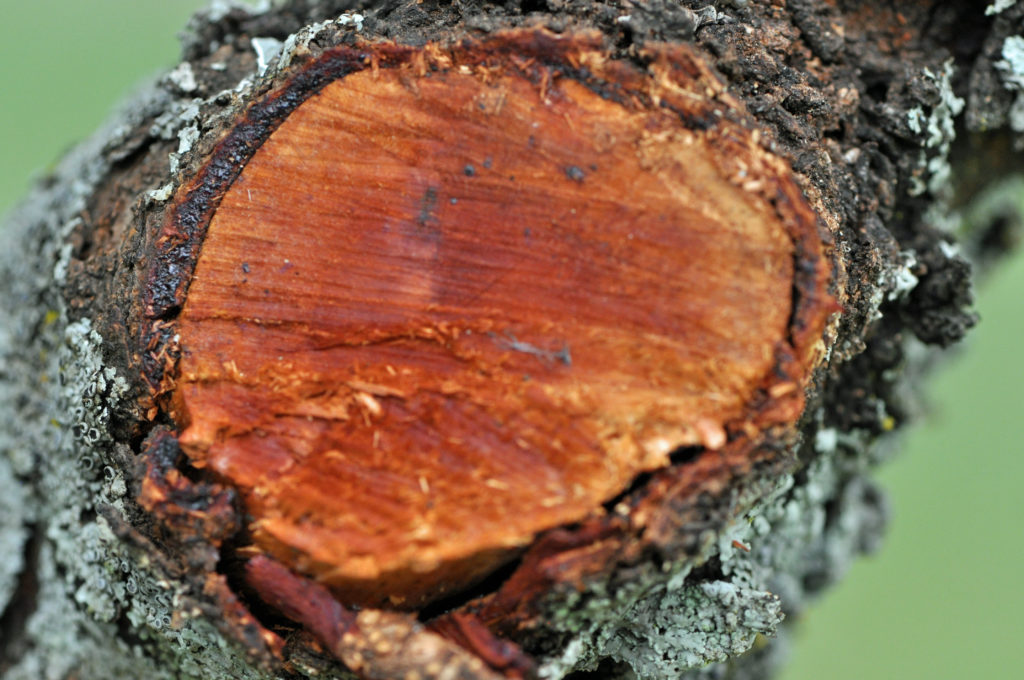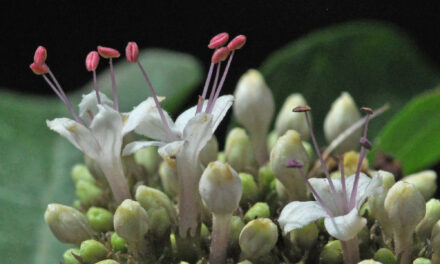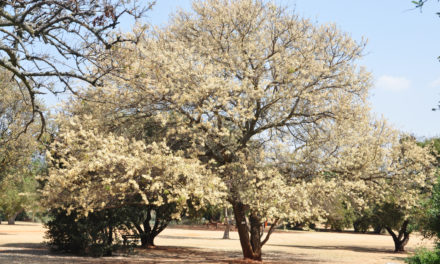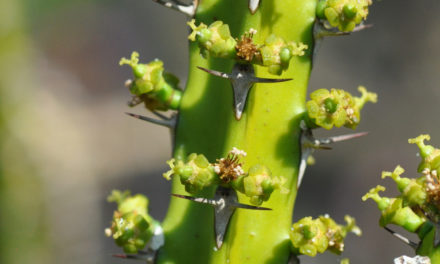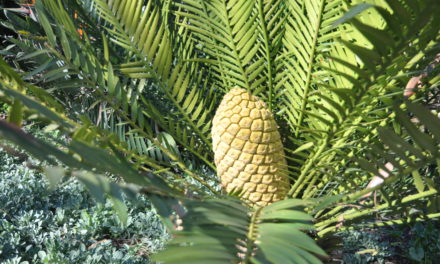General Info – summary
Dioecious shrub or Tree is up to 5m high with a wide crown. It is an arid area survivor with distinctive lenticels. Trifoliate Leaves have small leaflets with indistinct veins. Petioles are grooved above. Small, 5-merous, regular Flowers are in panicles. Male with a rudimentary pistil and free filaments. Female has a superior ovary, 3 styles and 5 staminodes. The small Fruit is a hairless drupe with reniform seeds.
Description
Searsia burchellii
Previous Names: Rhus burchellii, Rhus undulata var. burchellii, Rhus undulata var. tricrenata.
SA Tree No. 379.
Common names: (Aft) Karookoeniebos. (Eng) Karoo Kunibush, Karoo Kuni-rhus. (Sesotho) mokhoamphiri, tshilabele. (Setswana) motshotlho.
Family: Anacardiaceae. (Mango family), which has about 83 genera and 850+ species – including Cashew). About 80 species occur in South Africa. Hunting arrows have been made from straight stems. Resin canals are present and woolly stellate hairs cover all young parts. Leaves lack stipules. They may be deciduous or evergreen and usually alternate. Leaves are simple, trifoliate or digitally compound and imparipinnate. Leaflets are usually opposite. Crushed leaves may smell of turpentine. Trees are monoecious or dioecious with occasional bisexual Flowers. Flowers are small, greenish or yellowish white and usually regular. The Calyx has 4-7 sepals and there are 4-7 Petals. The number of Stamens is the same as, or twice the number of petals and the Anthers are versatile. The superior Ovary has up to 4 locules, each with a single ovule. The 1-5 Styles are free or connate and separated at the base. Fruit is usually an indehiscent fleshy drupe that provide food in dry areas. They contain a single quick growing Seed. The southern Africa genera containing trees on this website include Harpephyllum, Lannea, Loxostylis, Ozoroa, Sclerocarya and Searsia.
Name derivation: Searsia: Named after Paul Bigelow Sears a highly qualified American ecologist (December 17, 1891 – April 30, 1990). He pioneered the study of fossil pollen in the USA. All of the many Searsia species in South Africa have edible fruit that is rich in carbohydrates. burchellii: Named after William John Burchell an English explorer, naturalist and traveller in southern Africa. He was at the Cape from 1810 to 1815 and collected over 50 000 specimens. He also travelled to Brazil where his collection included insects. With each collection, he made copious and accurate notes!
Conservation: National Status: L C. (Least Concern). Assessed: 2018 (L. von Staden).
Tree
This is usually an intricately branched shrub but may develop into a small Tree up to 5m high (photo 263). The Crown may be wider than the plant is high (photo 263). The Bark is grey to brown and granular with prominent brown or orange Lenticels (usually raised corky oval or elongated area on the plant that allows the uncontrolled interchange of gases with the environment – photo 268). These are similar in appearance, but less noticeable, than in Warburgia salutaris (Pepper-bark tree). Squarish branches are spreading. Branchlets are spur-like (photo 272) and often spine tipped.
- 263. 2014/12/02. Walter Sisulu NBG. Photo: David Becking.
- 268. 2014/12/02. Walter Sisulu NBG. Photo: David Becking.
- 272. 2014/12/02. Walter Sisulu NBG. Photo: David Becking.
Leaves
The small alternate trifoliate (compound leaf with 3 leaflets) Leaves (photo 271) are crowded towards the ends of dwarf spur-like branchlets. The 3 olive or blue-green waxy Leaflets are obtriangular (triangular, with the apex at the base), hairless and slightly leathery. Leaflets tend to bend along the midrib (photo 267). The upper surface may be covered with a resinous substance, which is secreted by the plant and shines in the sun (photo 307 under Fruit). The central leaflet is slightly bigger than the other two (photo 271) and is up to 2,3 x 1,3cm. The Midrib is slightly raised on both surfaces. The lateral and net veins are indistinct. The Apex is square and is often notched (photo 267). The Base tapers and the Margins are entire (with a continuous margin, not in any way indented) and may be wavy towards the apex. The Petiole (leaf stalk) is up to 1,3cm long and deeply grooved above and may be winged (photo 271). Petiolules (stalks of leaflets) are absent.
- 267 2014.12.02 Walter Sisulu NBG. Photo: David Becking.
- 271 2014.12.02 Walter Sisulu NBG. Photo: David Becking.
Flowers
The small, creamy coloured and sweetly scented Flowers are in small panicles (indeterminate, branched inflorescence with stalked flowers) which are up to 6cm long (photo 898). They are actinomorphic (Regular, symmetrical. Flowers are vertically divisible into similar halves by more than 1 plane passing through the axis). Flowers are usually borne terminally with the leaves or in leaf axils. The Calyx has 5 Sepals which are joined at the base. The Corolla has 5 small Petals that are free (photo 405). The plant is dioecious (unisexual flowers with male and female parts on separate plants). In the Male Flowers, the 5 Stamens have free filaments. Their Anthers have 2 thecae (pollen sacs) present and dehiscence is longitudinal. A rudimentary Pistil is present. In Female Flowers, there are 5 staminodes (sterile stamens) and a single Pistil (a unit of the Gynoecium, the female element of the flower, composed of the Ovary, Style and Stigma). The superior Ovary has 3 free Styles (photo 898 – remains just visible on the developing fruit). Styles end in small Stigmas that are usually capitate (formed like a head). (Apr-May).
- 898 2015.01.20 Walter Sisulu NBG. Photo: David Becking.
- 405 2015.05.19 Walter Sisulu NBG. Photo: David Becking.
Fruit
The small, shiny green or reddish-brown Fruit (photo 307) is a hairless Drupe (a fleshy, 1-seeded indehiscent fruit with the seed enclosed in a stony endocarp; stone fruit like a peach). The diameter is about 6mm (photo 597). In this photo, the remains of the calyx is visible. The slightly flattened fruit is more or less ovoid, almost spherical or rectangular and becomes shiny reddish brown (photo 307). The small Seeds are reniform (kidney shaped) and lack endosperm (the starch and oil-containing tissue of many seeds; often referred to as the albumen). (May-Sep).
- 597. 2015/06/02. Walter Sisulu NBG. Photo: David Becking.
- 307. 2015/09/15. Walter Sisulu NBG. Photo: David Becking.
Distribution & Ecology
Searsia burchellii is endemic (restricted to a particular geographic location) in southern Africa. The plant naturally occurs in Northern Cape, Western Cape, Free State, Lesotho and western Namibia and includes Namaqualand and Bushmanland, Little Karoo and the great Karoo. This inland, dry area grassland plant commonly occurs in rocky areas. Birds consume the Fruit. Associated Butterflies include the endemic Namaqua Silverline or Namaqua Bar (Cigaritis namaquus) butterfly which is restricted from the North Western Cape to the boarder of Namibia – the succulent Karoo area. The Namaqua Arrowhead (Phasis clavum) butterfly, which also occurs in Namibia e.g., in Warmbad (just north of the boarder) and in Maltahohe in central Namibia. Both of these butterflies have larvae that feed on the Leaves.
Ethnobotany
Research done on plant extracts (Leaf and Bark) from Searsia burchellii indicates some antimicrobial activity. This may be important in view of increased drug resistance. Goats consume Leaves. The Wood has no clear distinction between hardwood and softwood (photo 283). Once growing, the plant needs little attention. However, both male and female plants are necessary for fruit development. Here cuttings from male and female plants would ensure this – more than seeds. Bushmen used the hard springy branches to make bows. Fruit is edible. Local medicine makes use of this plant.
- 283. 2018/01/11.Walter Sisulu NBG. Photo: David Becking.
References
Coates Palgrave, M. 2002. Keith Coates Palgrave Trees of Southern Africa, edn 3. Struik, Cape Town.
Lawrence, G. H. M, 1951. Taxonomy of Vascular Plants. The Macmillan Company, New York. Tenth Printing 1965.
Palmer, E. & Pitman, N. 1972. Trees of southern Africa. Balkema, Amsterdam, Cape Town.
van Wyk, B. & van Wyk, P. 1997 Field guide to Trees of Southern Africa. Struik, Cape Town.
von Staden, L. 2018. Searsia burchellii (Sond. ex Engl.) Moffett. National Assessment: Red List of South African Plants version 2020.1. Accessed on 2023/11/29.
Woodhall, S. 2020. Field Guide to Butterflies of South Africa, edn 2. Donnelley, RR, China.
http://www.kyffhauser.co.za/Plants1/Searsia_burchellii/Index.htm
http://posa.sanbi.org/flora/browse.php?src=SP
http://pza.sanbi.org/searsia-burchellii
Wikipedia, William John Burchell. This page was last edited on 1 August 2023, at 06:22 (UTC).

